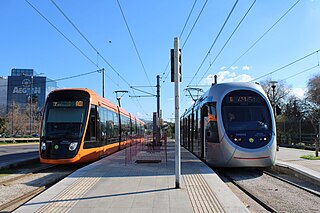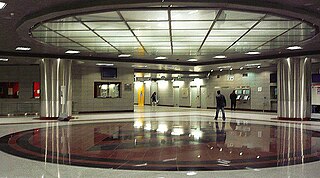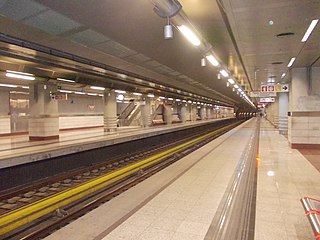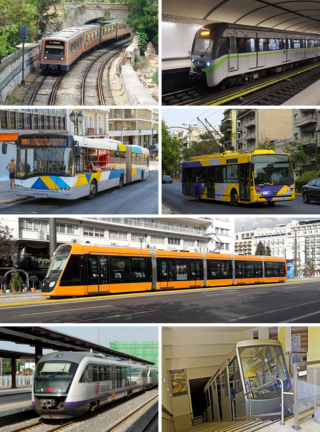
The Athens Metro is a rapid-transit system in Greece which serves the Athens urban area and parts of East Attica. Line 1 opened as a conventional steam railway in 1869 and electrified in 1904. In 1991, Attiko Metro S.A. constructed and extended Lines 2 and 3. It has significantly changed Athens by providing a much-needed solution to the city's traffic and air pollution problem, as well as revitalising many of the areas it serves. Extensions of existing lines are under development, as well as a new Line 4, whose central section began construction in October 2021. The Athens Metro is actively connected with the other means of public transport, such as buses, trolleys, the Athens Tram and the Athens Suburban Railway. The Athens Metro is hailed for its modernity and many of its stations feature works of art, exhibitions and displays of the archaeological remains found during its construction. Photography and video-taking is permitted across the whole network and street photographers often work in Athens Metro. This is the only metro system in Greece, until the Thessaloniki Metro begins operation in 2023.

The Athens Mass Transit System is the largest mass transit system of Greece. The system is run by the OASA S.A. organisation and serves Athens Urban Area and the Athens Metropolitan Area.

Syntagma is a station on the Athens Metro, located at Syntagma Square in the center of Athens, Greece. It serves as the transfer point between Line 3, Line 2 and the Athens Tram. When the Metro first opened, on 28 January 2000, the station was the terminal station for both the new lines. It is a transportation hub for O.SY. buses and the northern terminal for the Tram. It is the busiest station in the Athens transport system, located underneath Syntagma Square, the busiest square in Athens. It serves Ermou Street, the Houses of Parliament, various government agencies, foreign embassies and the National Garden.

The Athens–Piraeus Electric Railways, commonly abbreviated as ISAP, was a company which operated the Piraeus - Kifissia line from 1 January 1976 to 17 June 2011. Piraeus - Kifissia line was the oldest urban rapid transit system of Athens metropolitan area. The line opened in 1869 as a suburban railway line connecting Athens with its port of Piraeus and it was gradually converted to full rapid transit operations, making it one of the oldest metro lines in the world. The line which Isap S.A. operated evolved from the older Athens & Piraeus Railway and Lavrion Square-Strofyli railway.

The Thessaloniki Metro is an underground rapid-transit system under construction in Thessaloniki, Greece's second largest city. Estimates for the cost of the megaproject are €1.62 billion ($1.83 billion) for the main line and €640 million ($723 million) for the Kalamaria extension, for a total of €2.26 billion ($2.55 billion). The project is primarily funded with loans from the European Investment Bank (EIB) and the European Regional Development Fund (ERDF) and funds from the Greek government. Construction by a Greek-Italian consortium is overseen by Attiko Metro S.A., the Greek state-owned company which oversaw construction of the Athens Metro and Athens Tram.

Marousi, also known as Maroussi, is an Athens Metro station in Marousi, a northern suburb in Athens. The station is served by Line 1, and is 23.46 kilometres down the line from the southern terminus of Piraeus, between Nerantziotissa to the south and KAT to the north.

The Athens Tram is the modern public tram network system serving Athens, Greece. The system is owned and operated by STASY, which replaced Tram S.A. in June 2011.

Athens railway station is the main railway station of Athens, and the second largest station in Greece. Located in the central quarter of Kolonos, the railway station resulted from the merger of two separate railway terminals in 2005—Larissa station of the Piraeus–Platy railway towards central and northern Greece, and the Peloponnese station of the Piraeus–Patras railway that formerly linked Athens with the Peloponnese.

Line 2 of the Athens Metro runs entirely underground from Anthoupoli in the northwest to Elliniko in the south, via Syntagma. It first opened, between Sepolia and Syntagma, on 28 January 2000, with Line 3.

Line 3 of the Athens Metro runs from Dimotiko Theatro to Athens Airport, via Syntagma, although most of the trains reverse at Doukissis Plakentias. The section from Dimotiko Theatro to the tunnel portal east of Doukissis Plakentias is underground, and the section from Doukissis Plakentias to Airport is shared with Athens Suburban Railway trains, implementing a form of the Karlsruhe model.

Line 1 is the oldest of the three lines of the Athens Metro, running from Kifissia to Piraeus. The Athens-Piraeus Railway Company first opened the line, between Piraeus and Thiseio, on 27 February 1869. On 4 February 1885 Lavrion Square-Strofyli railway line opened between Attiki Square and Kifissia. These railway lines gradually merged and converted to a rapid-transit system. It was merged into the Athens Metro network upon the opening of Lines 2 and 3 on 28 January 2000.

Syngrou–Fix, also known as Sygrou–Fix on metro station signage, is an interchange station between Athens Metro Line 2 and the Athens Tram. The metro station opened on 15 November 2000, as part of the extension from Syntagma to Dafni, and the tram stop opened on 19 July 2004 as part of the initial scheme.

Dimotiko Theatro is a station in Piraeus, Greece. It is the southwestern terminus of Athens Metro Line 3. It opened in October 10, 2022, as part of the Line 3 extension to Piraeus.

Nikaia, shown as Nikea on the official map, is a station on Athens Metro Line 3, as part of the Piraeus extension. The entrance is located under Eleftherios Venizelos Square.

Elliniko is the current southern terminus on Athens Metro Line 2 since the Elliniko extension opened on 26 July 2013. With the opening of the station, travel time from Elliniko to Syntagma Square was reduced from 45 minutes to 20 minutes.

Ilioupoli, also known as Ilioupoli–Grigoris Lambrakis, is an intermediate station on Athens Metro Line 2. It opened with the Elliniko extension on 24 July 2013. The station is adjacent to Vouliagmenis Avenue.

Public transport in Athens comprises a bus network, various rail systems, funiculars, and maritime services to serve the more than 4 million inhabitants of the city spread over an area of 2928 km2.

Urban Rail Transport S.A., commonly abbreviated as STASY, is a Greek public transport operator of the Athens Metro and the Athens Tram. It is the metro and tram subsidiary of Transport for Athens (OASA), and is responsible for the operation and maintenance of the metro and tram network, including rolling stock, 59 tram stops, and 62 of the 66 metro stations.



















